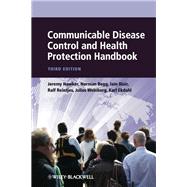
Note: Supplemental materials are not guaranteed with Rental or Used book purchases.
Purchase Benefits
What is included with this book?
Norman Begg is Chief Medical Officer, GlaxoSmithKline Biologicals, Wavre, Belgium
Iain Blair is Associate Professor, Department of Community Medicine, Faculty of Medicine and Health Sciences, United Arab Emirates University
Ralf Reintjes is Professor of Epidemiology and Public Health Surveillance, Hamburg, Germany; Adjunct Professor of Infectious Disease Epidemiology, Tampere, Finland
Julius Weinberg is Vice Chancellor, Kingston University, London, UK
Professor Karl Ekdahl is Head of Public Health Capacity and Communication Unit, European Centre for Disease Prevention and Control (ECDC), Stockholm, Sweden
Abbreviations.
Section 1: Introduction.
1.1 How to use this book.
1.2 Basic Concepts in the Epidemiology and Control of Infectious Disease.
1.3 Health Protection on-call.
Section 2: Common topics.
2.1 Meningitis and meningism.
2.2 Gastrointestinal infection.
2.3 Community acquired pneumonia.
2.4 Rash in pregnancy.
2.5 Rash and fever in children.
2.6 Illness in returning travellers.
2.7 Sexually Transmitted Infections.
2.8 Jaundice.
2.9 Infection in the immunocompromised.
2.10 Blood borne viral infections.
2.11 Vaccine Queries.
2.12 Individual measures against infections.
Section 3: Diseases.
3.1 Amoebic dysentery.
3.2 Anthrax.
3.3 Bacillus cereus.
3.4 Botulism.
3.5 Brucellosis.
3.6 Burkholderia.
3.7 Campylobacter.
3.8 Chickenpox and shingles (varicella-zoster infections).
3.9 Chikungunya.
3.10 Chlamydophila pneumoniae.
3.11 Chlamydophila psittaci.
3.12 Chlamydia trachomatis (genital).
3.13 Cholera.
3.14 CJD and other human transmissible spongiform encephalopathies.
3.15 Clostridium difficile.
3.16 Clostridium perfringens.
3.17 Coxsackievirus infections.
3.18 Cryptosporidiosis.
3.19 Cyclosporiasis.
3.20 Cytomegalovirus.
3.21 Dengue fever.
3.22 Diphtheria.
3.23 Encephalitis, acute.
3.24 Enterococci, including glycopeptide-resistant enterococci (GRE).
3.25 Epstein–Barr virus.
3.26 Escherichia coli O157 (and other E. coli gastroenteritis).
3.27 Giardiasis.
3.28 Gonorrhoea, syphilis and other acute STIs.
3.29 Hantavirus.
3.30 Head lice.
3.31 Helicobacter pylori.
3.32 Hepatitis A.
3.33 Hepatitis B.
3.34 Hepatitis C.
3.35 Delta hepatitis.
3.36 Hepatitis E.
3.37 Herpes simplex.
3.38 Haemophilus influenzae type b (Hib).
3.39 HIV.
3.40 Influenza.
3.41 Japanese B encephalitis.
3.42 Kawasaki Syndrome.
3.43 Legionellosis.
3.44 Leprosy.
3.45 Leptospirosis.
3.46 Listeria.
3.47 Lyme disease.
3.48 Malaria.
3.49 Measles.
3.50 Meningococcal infection.
3.51 Molluscum contagiosum.
3.52 MRSA (methicillin-resistant Staphylococcus aureus).
3.53 Mumps.
3.54 Mycoplasma.
3.55 Norovirus.
3.56 Paratyphoid fever.
3.57 Parvovirus B19 (fifth disease).
3.58 Plague.
3.59 Pneumococcal infection.
3.60 Poliomyelitis.
3.61 Q fever.
3.62 Rabies.
3.63 Relapsing Fever.
3.64 Respiratory syncytial virus (RSV).
3.65 Ringworm.
3.66 Rotavirus.
3.67 Rubella.
3.68 Salmonellosis.
3.69 Severe Acute Respiratory Syndrome (SARS).
3.70 Scabies
3.71 Shigella.
3.72 Smallpox.
3.73 Staphylococcal food poisoning.
3.74 Streptococcal infections.
3.75 Tetanus.
3.76 Threadworms.
3.77 Tick-borne encephalitis.
3.78 Toxocara.
3.79 Toxoplasmosis.
3.80 Tuberculosis.
3.81 Tularaemia.
3.82 Typhoid fever.
3.83 Rickettsial infections (incl. Typhus) Ehrlichia and Bartonella.
3.84 Vibrio parahaemolyticus.
3.85 Viral haemorrhagic fevers.
3.86 Warts and verrucae.
3.87 West Nile Virus.
3.88 Whooping cough.
3.89 Yellow fever.
3.90 Yersiniosis.
3.91 Other organisms.
Section 4: Services and organisations.
4.1 Surveillance of communicable disease.
4.2 Managing infectious disease incidents and outbreaks.
4.3 Infection Prevention and Control in the Community.
4.4 Healthcare Associated Infection.
4.5 Antimicrobial Resistance.
4.6 Risks to and from Health Care Workers.
4.7 Co-ordination of immunisation services.
4.8 Services for sexual health and HIV infection.
4.9 Services for tuberculosis control.
4.10 Travel Health.
4.11 Pandemic Preparedness and the Influenza A H1N1 2009 Pandemic.
4.12 Non-infectious environmental hazards.
4.13 Managing acute chemical incidents.
4.14 Managing acute radiation incidents.
4.15 Deliberate release of biological, chemical or radiological agents.
4.16 Media Relations and Crisis Communication.
4.17 Clinical Governance and Audit.
4.18 Global health.
Section 5: Communicable disease control in Europe.
5.1 WHO and International Health Regulations (IHR).
5.2 Collaboration within the European Union.
5.3 Detailed national example: organisational arrangements for health protection: England, 2010.
5.4 Austria.
5.5 Belgium.
5.6 Bulgaria.
5.7 Cyprus.
5.8 Czech Republic.
5.9 Denmark.
5.10 Estonia.
5.11 Finland.
5.12 France.
5.13 Germany.
5.14 Greece.
5.15 Hungary.
5.16 Iceland.
5.17 Ireland.
5.18 Italy.
5.19 Latvia.
5.20 Lithuania.
5.21 Luxembourg.
5.22 Malta.
5.23 The Netherlands.
5.24 Norway.
5.25 Poland.
5.26 Portugal.
5.27 Romania.
5.28 Slovakia.
5.29 Slovenia.
5.30 Spain.
5.31 Sweden.
5.32 Switzerland.
5.33 United Kingdom.
Appendix 1 Useful addresses and telephone numbers.
Appendix 2 Guidance documents and books.
Index.
The New copy of this book will include any supplemental materials advertised. Please check the title of the book to determine if it should include any access cards, study guides, lab manuals, CDs, etc.
The Used, Rental and eBook copies of this book are not guaranteed to include any supplemental materials. Typically, only the book itself is included. This is true even if the title states it includes any access cards, study guides, lab manuals, CDs, etc.